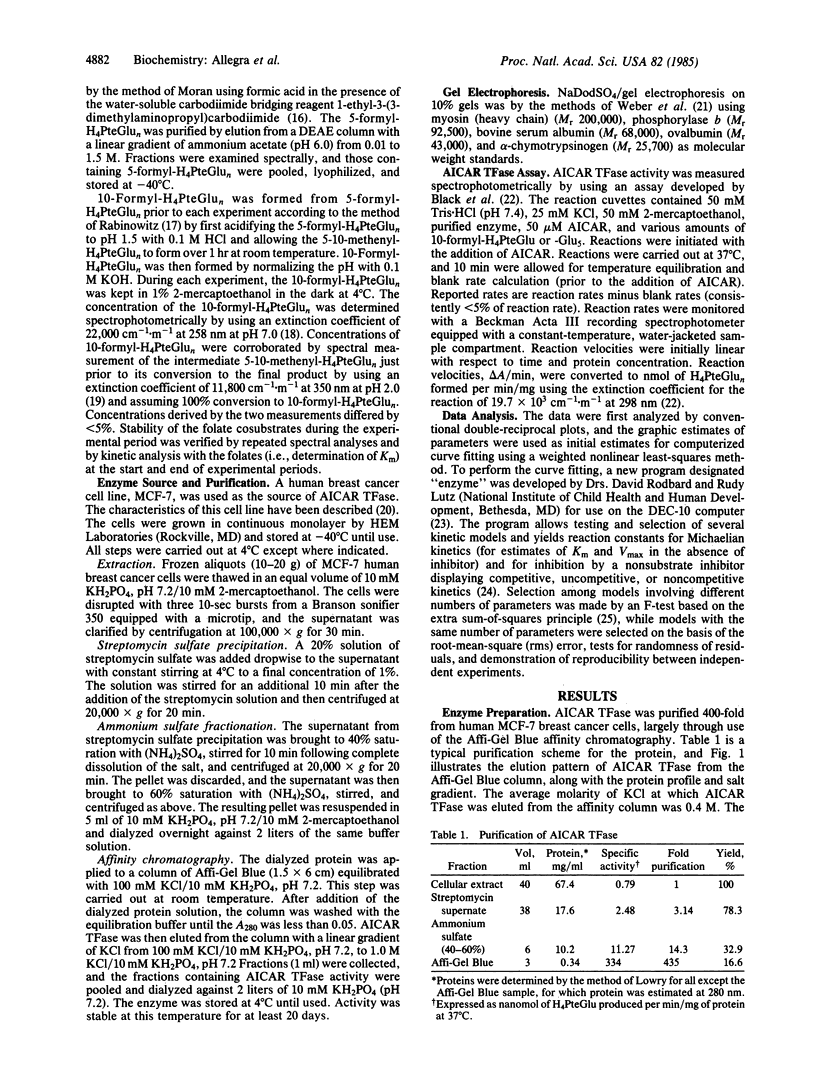Abstract
We report the enhanced inhibitory potency of methotrexate (MTX) polyglutamates and dihydrofolate pentaglutamate on the catalytic activity of phosphoribosylaminoimidazolecarboxamide (AICAR) transformylase purified from MCF-7 human breast cancer cells. In the present work, MTX (4-amino-10-methylpteroylglutamic acid) and dihydrofolate, both monoglutamates, were found to be weak competitive inhibitors of AICAR transformylase with Kis of 143 and 63 microM, respectively, and their inhibitory capacity was largely unaffected by the glutamated state of the folate cosubstrate. In contrast, MTX polyglutamates were found to be potent competitive inhibitors, with an approximately 10-fold increase in inhibitory potency with the addition of each glutamate group up to four (i.e., the pentaglutamate derivative). MTX tetra-and pentaglutamates were the most potent, with equivalent Kis of 5.6 X 10(-8) M or 2500-fold more potent than MTX. Dihydrofolate pentaglutamate was as potent an inhibitor as MTX pentaglutamate, with a Ki of 4.3 X 10(-8) M. The potent inhibitory effects demonstrated by the polyglutamate compounds when tested against the folate monoglutamate substrate were sharply curtailed when folate pentaglutamate was used as the substrate. MTX and dihydrofolate pentaglutamates were only 7- and 25-fold more potent than their monoglutamate counterparts under these conditions. A model depicting these complex interactions is postulated. These findings have significant implications regarding the mechanism of action of MTX.
Full text
PDF




Selected References
These references are in PubMed. This may not be the complete list of references from this article.
- Black S. L., Black M. J., Mangum J. H. A rapid assay for 5-amino-4-imidazolecarboxamide ribotide transformylase. Anal Biochem. 1978 Oct 1;90(1):397–401. doi: 10.1016/0003-2697(78)90042-8. [DOI] [PubMed] [Google Scholar]
- Caperelli C. A., Benkovic P. A., Chettur G., Benkovic S. J. Purification of a complex catalyzing folate cofactor synthesis and transformylation in de novo purine biosynthesis. J Biol Chem. 1980 Mar 10;255(5):1885–1890. [PubMed] [Google Scholar]
- Coward J. K., Parameswaran K. N., Cashmore A. R., Bertino J. R. 7,8-Dihydropteroyl oligo-gamma-L-glutamates: synthesis and kinetic studies with purified dihydrofolate reductase from mammalian sources. Biochemistry. 1974 Sep 10;13(19):3899–3903. doi: 10.1021/bi00716a013. [DOI] [PubMed] [Google Scholar]
- Fry D. W., Yalowich J. C., Goldman I. D. Rapid formation of poly-gamma-glutamyl derivatives of methotrexate and their association with dihydrofolate reductase as assessed by high pressure liquid chromatography in the Ehrlich ascites tumor cell in vitro. J Biol Chem. 1982 Feb 25;257(4):1890–1896. [PubMed] [Google Scholar]
- Galivan J. Evidence for the cytotoxic activity of polyglutamate derivatives of methotrexate. Mol Pharmacol. 1980 Jan;17(1):105–110. [PubMed] [Google Scholar]
- Gewirtz D. A., White J. C., Randolph J. K., Goldman I. D. Transport, binding, and polyglutamation of methotrexate in freshly isolated rat hepatocytes. Cancer Res. 1980 Mar;40(3):573–578. [PubMed] [Google Scholar]
- Jolivet J., Chabner B. A. Intracellular pharmacokinetics of methotrexate polyglutamates in human breast cancer cells. Selective retention and less dissociable binding of 4-NH2-10-CH3-pteroylglutamate4 and 4-NH2-10-CH3-pteroylglutamate5 to dihydrofolate reductase. J Clin Invest. 1983 Sep;72(3):773–778. doi: 10.1172/JCI111048. [DOI] [PMC free article] [PubMed] [Google Scholar]
- Jolivet J., Cowan K. H., Curt G. A., Clendeninn N. J., Chabner B. A. The pharmacology and clinical use of methotrexate. N Engl J Med. 1983 Nov 3;309(18):1094–1104. doi: 10.1056/NEJM198311033091805. [DOI] [PubMed] [Google Scholar]
- Jolivet J., Schilsky R. L., Bailey B. D., Drake J. C., Chabner B. A. Synthesis, retention, and biological activity of methotrexate polyglutamates in cultured human breast cancer cells. J Clin Invest. 1982 Aug;70(2):351–360. doi: 10.1172/JCI110624. [DOI] [PMC free article] [PubMed] [Google Scholar]
- MATHEWS C. K., HUENNEKENS F. M. Enzymic preparation of the 1,L-diastereoisomer of tetrahydrofolic acid. J Biol Chem. 1960 Nov;235:3304–3308. [PubMed] [Google Scholar]
- McGuire J. J., Bertino J. R. Enzymatic synthesis and function of folylpolyglutamates. Mol Cell Biochem. 1981 Aug 11;38(Spec No)(Pt 1):19–48. doi: 10.1007/BF00235686. [DOI] [PubMed] [Google Scholar]
- Moran R. G., Colman P. D. A simple procedure for the synthesis of high specific activity tritiated (6S)-5-formyltetrahydrofolate. Anal Biochem. 1982 May 1;122(1):70–78. doi: 10.1016/0003-2697(82)90252-4. [DOI] [PubMed] [Google Scholar]
- Mueller W. T., Benkovic S. J. On the purification and mechanism of action of 5-aminoimidazole-4-carboxamide-ribonucleotide transformylase from chicken liver. Biochemistry. 1981 Jan 20;20(2):337–344. doi: 10.1021/bi00505a017. [DOI] [PubMed] [Google Scholar]
- Munson P. J., Rodbard D. Ligand: a versatile computerized approach for characterization of ligand-binding systems. Anal Biochem. 1980 Sep 1;107(1):220–239. doi: 10.1016/0003-2697(80)90515-1. [DOI] [PubMed] [Google Scholar]
- Nair M. G., Baugh C. M. Synthesis and biological evaluation of poly-gamma-glutamyl derivatives of methotrexate. Biochemistry. 1973 Sep 25;12(20):3923–3927. doi: 10.1021/bi00744a021. [DOI] [PubMed] [Google Scholar]
- Poser R. G., Sirotnak F. M., Chello P. L. Differential synthesis of methotrexate polyglutamates in normal proliferative and neoplastic mouse tissues in vivo. Cancer Res. 1981 Nov;41(11 Pt 1):4441–4446. [PubMed] [Google Scholar]
- Rosenblatt D. S., Whitehead V. M., Vera N., Pottier A., Dupont M., Vuchich M. J. Prolonged inhibition of DNA synthesis associated with the accumulation of methotrexate polyglutamates by cultured human cells. Mol Pharmacol. 1978 Nov;14(6):1143–1147. [PubMed] [Google Scholar]
- Schilsky R. L., Bailey B. D., Chabner B. A. Methotrexate polyglutamate synthesis by cultured human breast cancer cells. Proc Natl Acad Sci U S A. 1980 May;77(5):2919–2922. doi: 10.1073/pnas.77.5.2919. [DOI] [PMC free article] [PubMed] [Google Scholar]
- Smith G. K., Mueller W. T., Wasserman G. F., Taylor W. D., Benkovic S. J. Characterization of the enzyme complex involving the folate-requiring enzymes of de novo purine biosynthesis. Biochemistry. 1980 Sep 2;19(18):4313–4321. doi: 10.1021/bi00559a026. [DOI] [PubMed] [Google Scholar]
- Weber K., Pringle J. R., Osborn M. Measurement of molecular weights by electrophoresis on SDS-acrylamide gel. Methods Enzymol. 1972;26:3–27. doi: 10.1016/s0076-6879(72)26003-7. [DOI] [PubMed] [Google Scholar]
- White J. C. Reversal of methotrexate binding to dihydrofolate reductase by dihydrofolate. Studies with pure enzyme and computer modeling using network thermodynamics. J Biol Chem. 1979 Nov 10;254(21):10889–10895. [PubMed] [Google Scholar]


